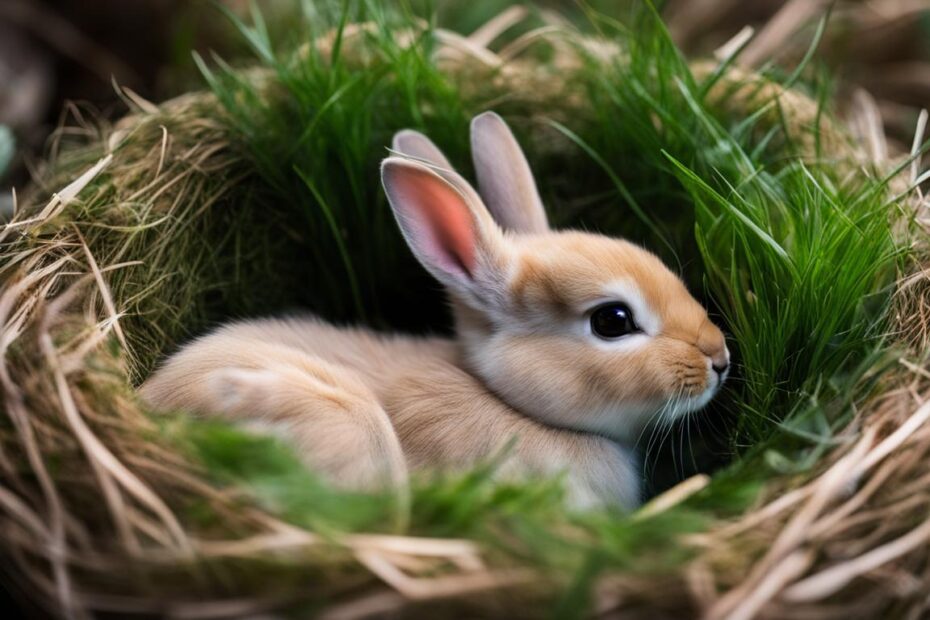Are you curious about how long rabbits stay in the nest? Understanding rabbit nesting habits and the factors that influence their nesting behaviors is essential for their care and well-being. In this article, we will explore the nesting period of rabbits, the duration that baby rabbits typically spend in the nest, and important considerations for rabbit care. Let’s dive in!
According to experts, baby rabbits stay in the nest until they are about three weeks old. The nests, which are shallow depressions in the ground covered with dry grass or fur, provide a safe haven for the newborn rabbits. During this nesting period, it is important to keep the babies safe from predators like cats and dogs. It is recommended to place a basket over the nest during the daytime and remove it when your pets are inside for the evening. The mother rabbit will continue to feed her babies at night. If you find a rabbit nest on your property, it is crucial not to relocate it as the mother will not be able to find her babies.
Key Takeaways:
- Rabbits stay in the nest until they are about three weeks old.
- The nests are shallow depressions in the ground covered with dry grass or fur.
- During the nesting period, it is important to protect the babies from predators.
- Place a basket over the nest during the daytime and remove it when your pets are inside for the evening.
- Do not relocate a rabbit nest as the mother will not be able to find her babies.
How Long Rabbits Stay in Nest
Tips to Keep Baby Bunnies Safe
When it comes to protecting baby bunnies, there are a few important measures you can take to ensure their safety. These tips will help you create a secure environment for the nest and minimize the risk of any unwanted interactions with pets or predators. how often rabbits pee
1. Cover the nest during the daytime
One effective way to keep baby bunnies safe is to place a basket or a protective cover over the nest during the daytime. This provides a physical barrier that can deter predators, such as cats and dogs, from accessing the nest. Make sure the cover is well-secured and doesn’t pose a threat to the bunnies or their mother.
2. Remove the cover when pets are inside
It’s crucial to remove the covering from the nest when your pets are inside for the evening. This allows the mother rabbit to access the nest and feed her babies at night. By creating a schedule that accommodates both the safety of the nest and the needs of your pets, you can help ensure that the baby bunnies receive proper care.
3. Leash and monitor your pets
During the nesting period, it’s important to leash your pets and closely monitor their interactions with the environment. Keep a watchful eye on your pets whenever they are outside, and make sure they are unable to access the nest. This will prevent any potential harm to the baby bunnies and maintain a safe environment for them to grow.
4. Avoid relocating the nest
If you come across a rabbit nest on your property, it’s essential not to relocate it. Moving the nest can cause the mother rabbit to lose track of her babies, making it difficult for her to find and care for them. It’s best to leave the nest undisturbed and let nature take its course. Trust in the mother rabbit’s instincts to protect and nurture her young.
By following these tips, you can help keep baby bunnies safe and create a nurturing environment for their growth. Remember to respect the natural instincts of the mother rabbit and avoid interfering with the nest unnecessarily. By providing the right conditions and taking precautions, you can contribute to the well-being of these adorable creatures.
The Nesting Habits of Rabbits
Rabbits have fascinating nesting habits that are essential for the survival of their young. Understanding these habits can help us protect and care for these adorable creatures. Rabbits typically nest between the months of March and September, with their nesting period lasting until the babies are around three weeks old. During this time, the mother rabbit creates a shallow depression in the ground and lines it with dry grass or fur to create a warm and safe environment for her newborns. rabbit urination frequency
The choice of nesting materials is crucial for the well-being of the baby rabbits. The mother rabbit gathers dry grass or fur to line the nest, providing insulation and protection against the elements. This nesting material helps regulate the temperature inside the nest and keeps the babies cozy and comfortable. It also provides camouflage, making it harder for predators to spot the nest.
The importance of protecting these nests cannot be overstated. Rabbits are at high risk during the nesting period, especially due to interactions with cats and dogs. To keep the nests safe, it is recommended to place a basket over the nest during the daytime and remove it when pets are indoors. This simple measure can prevent unwanted interactions and ensure the safety of the baby rabbits. rabbit bathroom habits
| Nesting Period | Nesting Materials | Protection |
|---|---|---|
| March to September | Dry grass or fur | Use a basket as protection from predators |
| Approximately three weeks | Provides insulation and camouflage | Remove basket when pets are indoors |
By understanding and respecting the nesting habits of rabbits, we can create a safe environment and ensure the well-being of these wonderful creatures. Providing the right nesting materials and taking measures to protect the nests from predators are simple yet effective ways to support rabbit populations and contribute to their conservation.
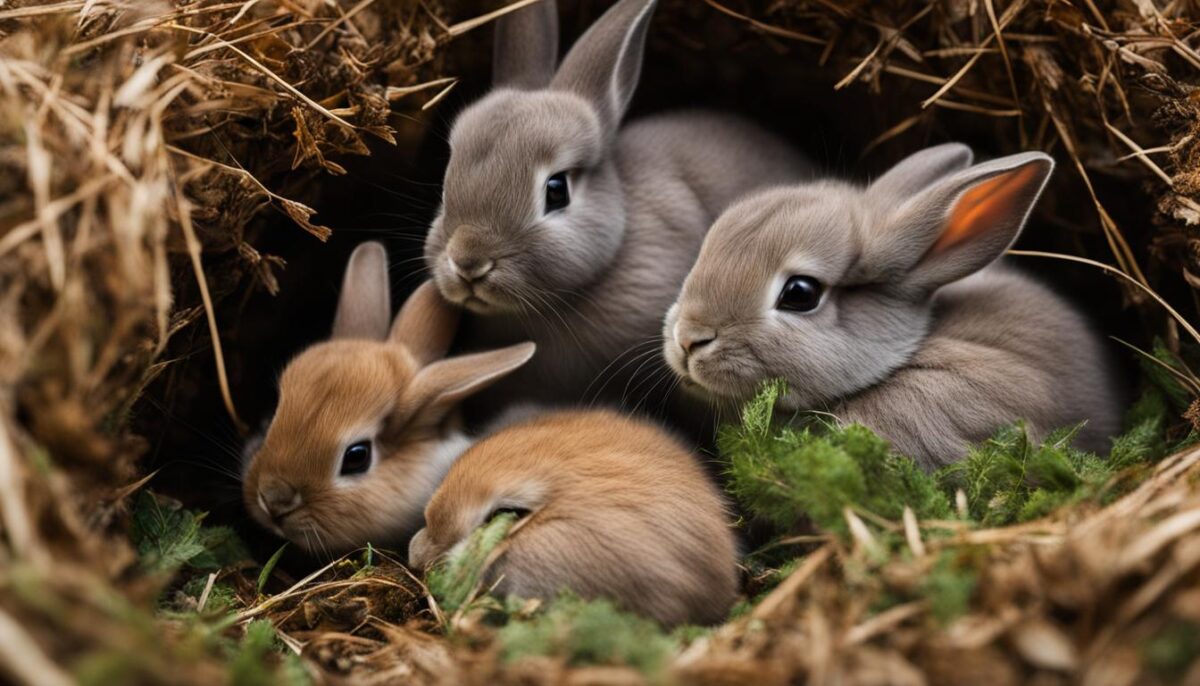
Rabbit Nesting Facts
- Rabbits nest between March and September.
- The nesting period lasts approximately three weeks.
- The mother rabbit lines the nest with dry grass or fur.
- Protecting the nests from predators is crucial.
- Using a basket as a protective cover during the daytime is recommended.
“Understanding and respecting the nesting habits of rabbits is crucial for their well-being and conservation. By providing the right nesting materials and protecting the nests from predators, we can contribute to the survival of these adorable creatures.” – Wildlife Expert
How Often Rabbits Pee and Their Bathroom Habits
When it comes to rabbits, their bathroom habits are quite interesting. They have a unique behavior known as “double elimination,” where they excrete and eat their own droppings to obtain maximum nutrients. But what about their urination habits? How often do rabbits pee? rabbit urinating schedule
The frequency of rabbit urination can vary depending on various factors, including diet and hydration levels. Generally, rabbits tend to pee quite frequently throughout the day. It is essential to provide them with a proper diet and access to fresh water to ensure regular urination and maintain optimal health.
Rabbits have a sensitive urinary system, and any changes in their urination patterns can indicate a potential health issue. If you notice any significant changes, such as increased or decreased urination, it is best to consult a veterinarian for proper evaluation and guidance.rabbits peeing habits
Key Points:
- Rabbits have a unique bathroom habit called “double elimination,” where they excrete and consume their own droppings for maximum nutrient intake.
- The frequency of rabbit urination can vary depending on factors like diet and hydration levels.
- Regular urination is essential for rabbits’ overall health, so it is crucial to provide them with a proper diet and access to fresh water.
- Significant changes in urination patterns may indicate a health issue, and it is recommended to seek veterinary advice in such cases.
| Aspect | Rabbit Peeing Behavior |
|---|---|
| Frequency | Varies depending on diet and hydration levels, but generally rabbits urinate frequently throughout the day. |
| Importance of Hydration | Proper hydration is crucial to maintain regular urination and support overall health in rabbits. |
| Changes in Urination | Any significant changes in urination patterns should be monitored as they may indicate potential health issues. |
Protecting Rabbit Nests from Predators
When it comes to protecting rabbit nests from predators, there are several measures you can take to ensure the safety of these vulnerable creatures. Rabbits face threats from animals such as cats and dogs, which can pose a significant danger to their nests and offspring. To safeguard the nests, it is essential to act proactively and implement preventive strategies.how often do rabbits go to the bathroom
One effective approach is to place a basket or similar protective cover over the nest during the daytime. This physical barrier can help deter predators from accessing the nest and its contents. However, it is important to remove the cover when your pets are inside for the evening, allowing the mother rabbit to feed her babies at night. This temporary protection during the day can significantly reduce the risk of predation.
Another crucial step in protecting rabbit nests is to leash your pets and monitor them closely during the nesting period. This ensures that they do not have the opportunity to disturb or harm the nests. By keeping a watchful eye on your pets, you can prevent unwanted interactions that could potentially be harmful to the newborn rabbits.
It is important to note that relocating a rabbit nest is strongly discouraged, as the mother rabbit may not be able to locate her babies if the nest is moved. Instead, it is best to leave the nest undisturbed and seek advice from a wildlife center if you believe there is a need for intervention. By taking these protective measures, you can create a safer environment for rabbits and contribute to their overall well-being.
Table: Rabbit Nest Protection Strategies
| Protection Strategy | Description |
|---|---|
| Use a Basket or Cover | Place a basket or similar protective cover over the nest during the day to deter predators. |
| Remove Cover at Night | Take off the protective cover when your pets are inside for the evening, allowing the mother rabbit to feed her babies. |
| Leash and Monitor Pets | Keep your pets leashed and closely monitor them during the nesting period to prevent unwanted interactions with the nests. |
| Avoid Nest Relocation | Do not relocate a rabbit nest, as it may prevent the mother rabbit from finding her babies. |
Habitat and Breeding Habits of Rabbits
Rabbits are fascinating creatures that have specific habitat preferences and unique breeding habits. Understanding their natural environment and reproductive behavior is essential for their overall well-being.
Habitat
Rabbits typically have a small home range, usually around 10 acres or less. They prefer habitats that provide a mix of open spaces and cover, such as grasslands, meadows, and shrubby areas. These environments offer a variety of food sources and protection from predators. Rabbits also create shelters called forms, which are made from grass or weeds, and scrapes beneath the cover of vegetation. These forms provide additional protection and camouflage for the rabbits.
Breeding Season
Rabbits are polygamous and start breeding as young as six months old. The breeding season occurs from February to September, with the peak being between March and May. During this time, male rabbits, known as bucks, become more active and may display territorial behaviors. Female rabbits, or does, become receptive to mating and may exhibit nesting behaviors.
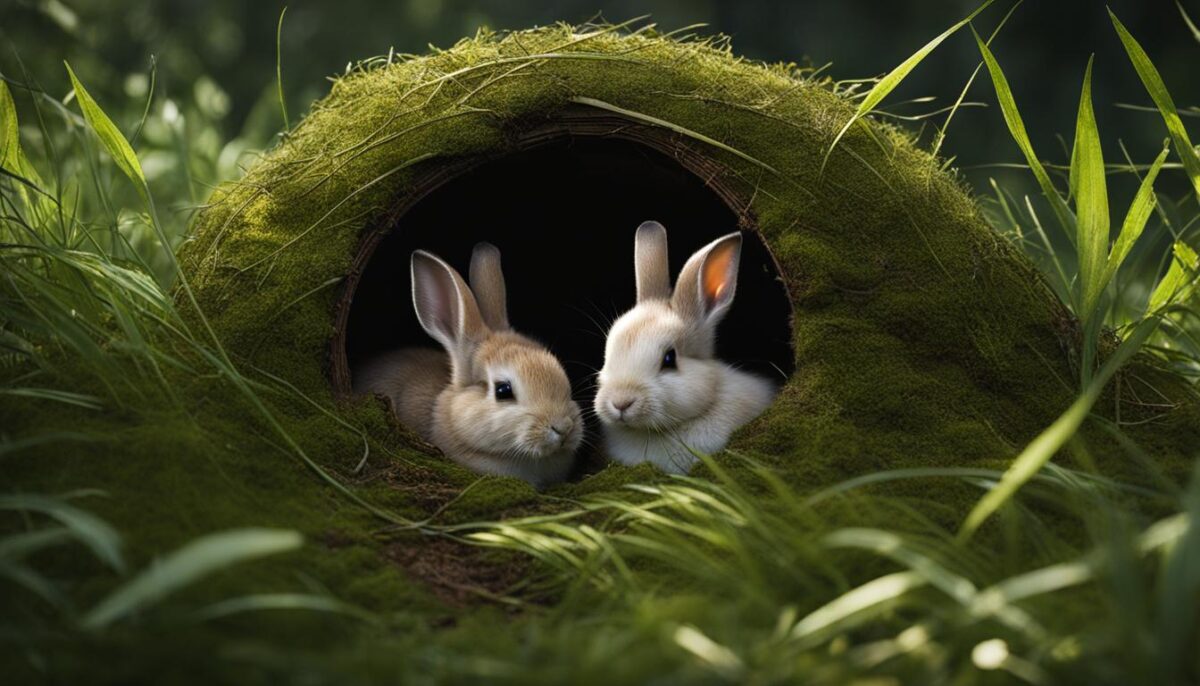
Nesting Habits
When a female rabbit is ready to give birth, she digs a small, shallow depression for her nest, lining it with grass and her own fur. The nest is camouflaged with grass and leaves on top to further protect the babies. The young rabbits, known as kits, are born blind and without fur, but they quickly develop and leave the nest at around three weeks old. It is important to avoid disturbing the nest during this period to ensure the mother can care for her offspring without stress or interference. rabbit pee frequency
Breeding Success Factors
Several factors can influence the breeding success of rabbits. A healthy diet rich in fresh greens, hay, and pellets provides the necessary nutrients for reproductive health. Access to clean water is also crucial for hydration and overall well-being. Additionally, providing a safe and secure habitat with adequate cover and protection from predators enhances the chances of successful breeding and the survival of the offspring.
| Aspect | Key Factors |
|---|---|
| Diet | Fresh greens, hay, pellets |
| Water | Clean and accessible |
| Habitat | Safe, with adequate cover and protection |
In summary, understanding the habitat preferences and breeding habits of rabbits is essential for providing them with a suitable environment and ensuring their reproductive success. By creating a safe and natural habitat and supporting their dietary needs, we can promote the well-being of these fascinating creatures.
Encouraging Rabbits to Leave Your Property
If you want to deter rabbits from nesting on your property, there are several effective strategies you can employ. Visual deterrents can be a simple yet effective way to discourage rabbits from making a home on your land. Consider placing garden gnomes, beach balls, or large pinwheels in the areas where rabbits are most active. These objects create movement and visual stimulation that can make rabbits feel uncomfortable and less likely to want to nest nearby.
Motion-detecting sprinklers can also be a valuable tool in deterring rabbits. These devices are equipped with sensors that detect movement and automatically spray water when triggered. By placing motion-detecting sprinklers in areas where rabbits tend to nest, you can startle and discourage them from staying on your property.
To create a less attractive environment for rabbits, remove brush piles and keep your grass cut short. This eliminates potential hiding spots and reduces the appeal of your property as a nesting site. By implementing these simple yet effective measures, you can encourage rabbits to seek alternative locations for nesting, helping to protect your land and preserve your garden.
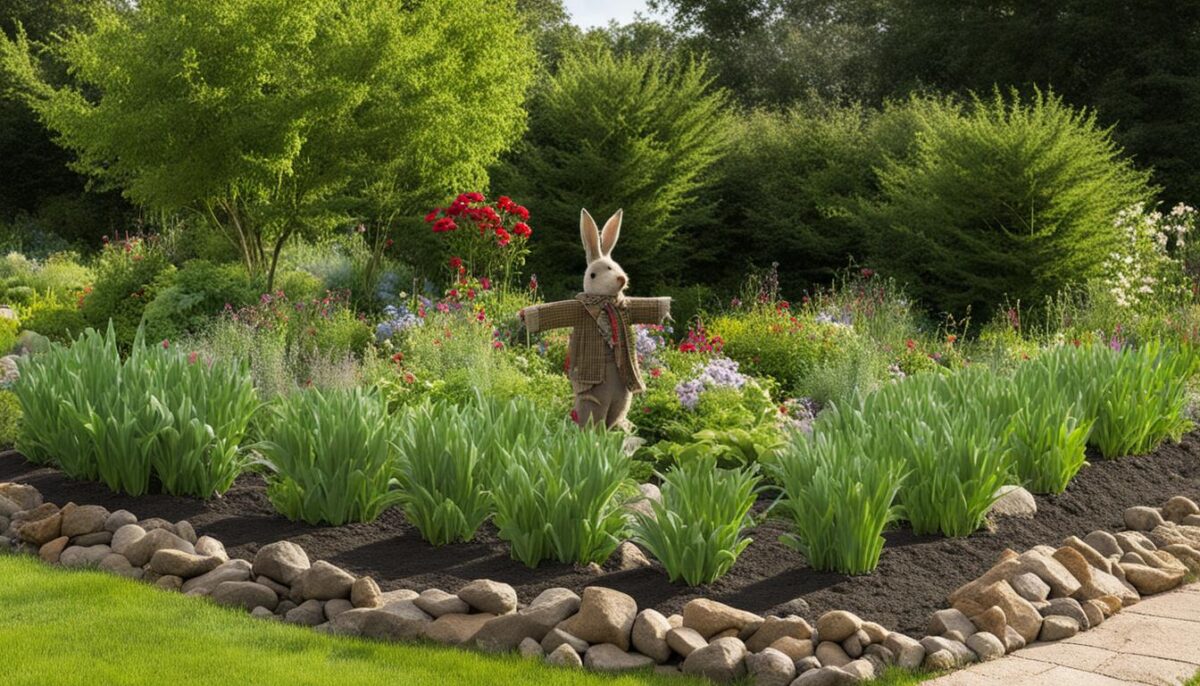
Table: Effective Rabbit Deterrents
| Deterrent | Description |
|---|---|
| Visual Deterrents | Objects such as garden gnomes or pinwheels that create movement and visual stimulation to make rabbits uncomfortable. |
| Motion-Detecting Sprinklers | Devices equipped with sensors that detect movement and spray water when triggered, startling and deterring rabbits. |
| Removing Brush Piles | Eliminating potential hiding spots and reducing the appeal of your property as a nesting site. |
| Keeping Grass Cut Short | Creating a less attractive environment for rabbits by eliminating tall grass that can serve as cover. |
“By implementing these simple yet effective measures, you can encourage rabbits to seek alternative locations for nesting, helping to protect your land and preserve your garden.”
Wild Rabbit Diet and Eating Habits
Understanding the diet and eating habits of wild rabbits is essential for their well-being and survival. These adorable creatures primarily feed on a variety of plants and vegetation found in their natural habitats. Let’s take a closer look at what wild rabbits eat and their eating behavior.
Wild Rabbit Diet: Wild rabbits are herbivores, meaning they rely solely on plants for sustenance. Their diet consists mainly of clover, grass, and various other types of plants. In times of scarcity, they may also consume twigs and bark to fulfill their nutritional needs. During the warmer months, wild rabbits may nibble on flower and vegetable plants, while in the colder months, they may target the bark of fruit and ornamental trees and shrubs.
“Wild rabbits primarily eat clover, grass, and other plants. They may also consume twigs and even bark if food sources are scarce.”
Eating Behavior: Wild rabbits have a unique eating behavior known as “double elimination.” This involves excreting and eating their own droppings to maximize nutrient intake. By re-digesting their droppings, they can extract additional essential nutrients from their food. This behavior also allows them to efficiently process and utilize plant fiber, which is a vital component of their diet.
It is fascinating to observe how wild rabbits adapt their eating habits based on the availability of food sources and the changing seasons. Their ability to thrive on a variety of plants and their efficient digestion system contribute to their successful survival in the wild.
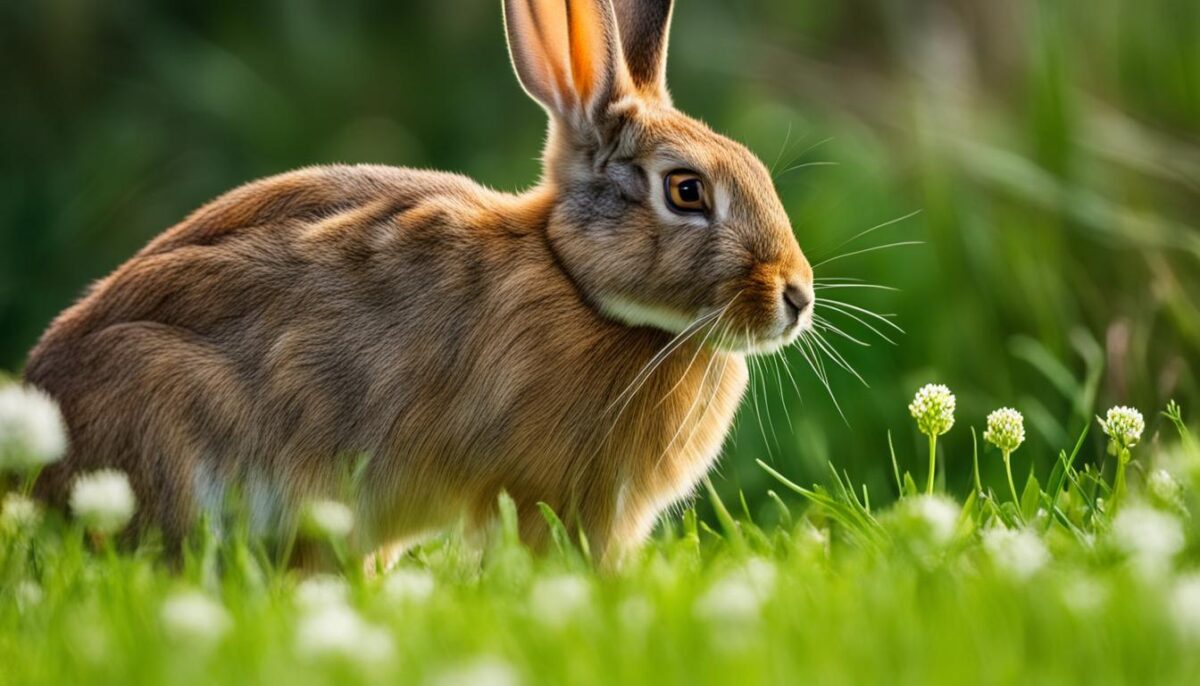
Table: Wild Rabbit Diet
| Food Sources | Seasonal Preference |
|---|---|
| Clover | Year-round |
| Grass | Year-round |
| Twigs and Bark | Scarcity of food |
| Flower and Vegetable Plants | Spring and Summer |
| Tree and Shrub Bark | Fall and Winter |
Table: This table outlines the different food sources consumed by wild rabbits and their seasonal preferences. It provides valuable insights into their diet and helps us understand the plants they target throughout the year.
By gaining a deeper understanding of wild rabbits’ diet and eating behavior, we can appreciate their incredible adaptability and contribute to their conservation in their natural habitats.
Protecting Plants from Rabbit Damage
When it comes to protecting your plants from rabbit damage, there are several effective strategies you can implement. One of the most reliable methods is to construct a well-built fence around your garden. A two-foot high chicken wire, supported by posts every six to eight feet, can effectively keep rabbits out. Additionally, you can use movable fence panels to safeguard new plantings during their most vulnerable stage.
Another option to consider is the use of physical barriers. Commercial tree wraps or plastic tree guards can prevent rabbits from nibbling on tree bark. Barriers made of hardware cloth or poultry wire can also be quite effective in protecting your plants. It’s important to ensure that these barriers are properly installed and secure, leaving no gaps for rabbits to sneak through.
Chemical repellents and scare devices can also play a role in deterring rabbits from your plants. Repellents can be sprayed on plants to make them less appealing to rabbits, while scare devices like scare tape or balloons can startle and discourage them. However, it’s crucial to follow the instructions and guidelines provided by the manufacturer when using chemical repellents to ensure the safety of your plants and the environment.
To further deter rabbits from damaging your plants, you can modify their habitat. Removing brush piles and keeping the grass cut short can create an environment where rabbits feel less safe, making your yard less attractive to them. By implementing a combination of these strategies, you can effectively protect your plants from rabbit damage and enjoy a flourishing garden.
Wild Rabbit Population in Suburban Areas
Wild rabbits are a common sight in suburban neighborhoods, thanks to their adaptability to a variety of habitats. These furry creatures are attracted to areas with a mixture of residential yards, parks, and office complexes, as these spaces provide an abundance of food and shelter. Suburban areas, with their diverse vegetation and patches of greenery, offer rabbits plenty of edges and hiding spots that they can utilize for nesting and foraging.
The population of wild rabbits in suburban areas can fluctuate throughout the year due to various factors. Predation, availability of food and water, changes in habitat, and natural population cycles all contribute to the rise and fall of wild rabbit numbers. While some homeowners may view an increase in rabbit population as a nuisance, it is important to consider the role they play in local ecosystems. Wild rabbits can serve as a vital food source for predators such as foxes, raptors, and snakes, helping maintain a healthy balance in the suburban wildlife community.
To manage the wild rabbit population in suburban areas, it is essential to focus on prevention rather than attempting to control or eliminate them entirely. Implementing measures to deter rabbits from nesting on your property, such as using visual deterrents like garden gnomes or large pinwheels, can be effective in minimizing their presence. Additionally, creating an environment that is less attractive to rabbits by removing brush piles and maintaining short grass can help discourage them from staying in your yard.
| Wild Rabbit Population in Suburban Areas | Rabbits in Suburban Neighborhoods | Rabbit Habitats in Suburbs |
|---|---|---|
| Fluctuates throughout the year | Common sight in residential areas | Prefer areas with diverse vegetation and edges |
| Factors influencing population include predation, food availability, and habitat changes | Can be considered a nuisance by some homeowners | Seek shelter in residential yards, parks, and office complexes |
| Play a role in the local ecosystem as a food source for predators | Can contribute to a healthy balance in suburban wildlife communities | Have adaptability to a variety of habitats in suburban areas |
By understanding the habits and preferences of wild rabbits in suburban areas, we can coexist with these furry neighbors while taking appropriate measures to prevent any potential problems. Maintaining a balance between wildlife conservation and managing their impact on our properties is key to creating a harmonious environment for both humans and rabbits.
Differentiating Between Wild and Domestic Rabbits
When it comes to rabbits, there are distinct differences between wild and domestic breeds. Understanding these differences can help you identify and better understand the behavior of rabbits you encounter. Here are some key characteristics to look out for:
- Appearance: Wild rabbits, typically cottontails, are brown with white tails. Domestic rabbits, on the other hand, come in a wide range of coat colors and patterns.
- Ear Position: Wild rabbits generally have ears that stand up straight. Domestic rabbits can have ears that stand up, hang down, or fall somewhere in between.
- Size: Domestic rabbit breeds can vary significantly in size, from small dwarf breeds to larger breeds like Flemish Giants.
Identifying whether a rabbit is wild or domestic can be helpful in determining how to interact with or care for the animal. Domestic rabbits are typically more accustomed to human interaction and can make great pets, while wild rabbits are best appreciated from a distance.
As you encounter and observe rabbits, take note of their appearance, ear position, and overall behavior to determine if they are wild or domestic. Remember, wild rabbits are an important part of our ecosystem, and it is best to let them thrive in their natural habitats.
The Differences between Wild and Domestic Rabbits
Wild rabbits vs. domestic rabbits – it’s essential to understand how to differentiate between these two types of rabbits. Here are some key differences that can help you distinguish between them:
| Characteristics | Wild Rabbits | Domestic Rabbits |
|---|---|---|
| Appearance | Typically brown with white tails | Variety of coat colors and patterns |
| Ear Position | Ears stand up straight | Can have ears that stand up, hang down, or fall somewhere in between |
| Size | Varies, but generally smaller | Can vary from small dwarf breeds to larger breeds |
| Behavior | Prefer to avoid human interaction | More accustomed to human interaction |
Conclusion
Understanding the nesting habits of rabbits is essential for protecting their nests and ensuring the well-being of these adorable creatures. Baby rabbits typically stay in the nest until they are around three weeks old, relying on their mother for food and protection. During this nesting period, it is important to take precautions to keep the nests safe from predators like cats and dogs.
One effective way to protect rabbit nests is by placing a basket over the nest during the daytime and removing it when your pets are inside for the evening. This allows the babies to remain safe during the day and get fed by their mother at night. It is also crucial to leash your pets and closely monitor them during the nesting period to prevent any unwanted interactions.
Remember, relocating a rabbit nest is strongly discouraged as the mother may not be able to find her babies in a new location. Leaving the nest undisturbed and seeking advice from a wildlife center if necessary is the best course of action. By understanding and respecting rabbit nesting habits, we can play our part in protecting these precious creatures.
FAQ
How long do baby rabbits stay in the nest?
Baby rabbits typically stay in the nest until they are around three weeks old.
What materials do rabbits use to build their nests?
Rabbits build their nests using shallow depressions in the ground that are covered with dry grass or fur.
How can I keep baby bunnies safe from predators?
To keep baby bunnies safe, you can place a basket over the nest during the daytime and remove it when your pets are inside for the evening.
What should I do if I find a rabbit nest on my property?
It is crucial not to relocate the nest as the mother rabbit may not be able to find her babies. Leave the nest undisturbed and seek advice from a wildlife center if necessary.
How often do rabbits pee?
Rabbits typically pee quite frequently, with the frequency varying depending on factors such as diet and hydration levels.
How can I protect rabbit nests from predators?
To protect rabbit nests, you can place a basket over the nest during the daytime and leash your pets while closely monitoring them.
What is the nesting period of rabbits?
Rabbits stay in the nest until they are about three weeks old, at which point they start venturing out on their own.
How can I deter rabbits from nesting on my property?
You can use visual deterrents like garden gnomes or motion-detecting sprinklers to discourage rabbits from nesting. Removing brush piles and keeping the grass cut short can also help.
What do wild rabbits eat?
Wild rabbits primarily eat clover, grass, and other plants. They may also consume twigs and bark if food sources are scarce.
How can I protect my plants from rabbit damage?
A well-constructed fence, barriers made of hardware cloth or poultry wire, and chemical repellents can help protect plants from rabbit damage.
Where are wild rabbits commonly found?
Wild rabbits are often found in suburban areas with habitats that have a variety of edges, such as yards, parks, and office parks.
How can I differentiate between wild and domestic rabbits?
Wild rabbits are typically brown with white tails, while domestic rabbits can vary in size, coat color, and ear position.
Why is it important to understand rabbit nesting habits?
Understanding rabbit nesting habits is crucial for their care and safety. It allows us to take appropriate measures to protect the nests and ensure the well-being of these adorable creatures.
Source Links
- https://web.extension.illinois.edu/askextension/thisQuestion.cfm?ThreadID=12717&catID=219&AskSiteID=90
- https://www.humanesociety.org/resources/what-do-about-wild-rabbits
- https://www.theweathernetwork.com/en/news/nature/animals/baby-bunny-safety-tips-cottontail-rabbit-nest-spring-dandelions-string-test


